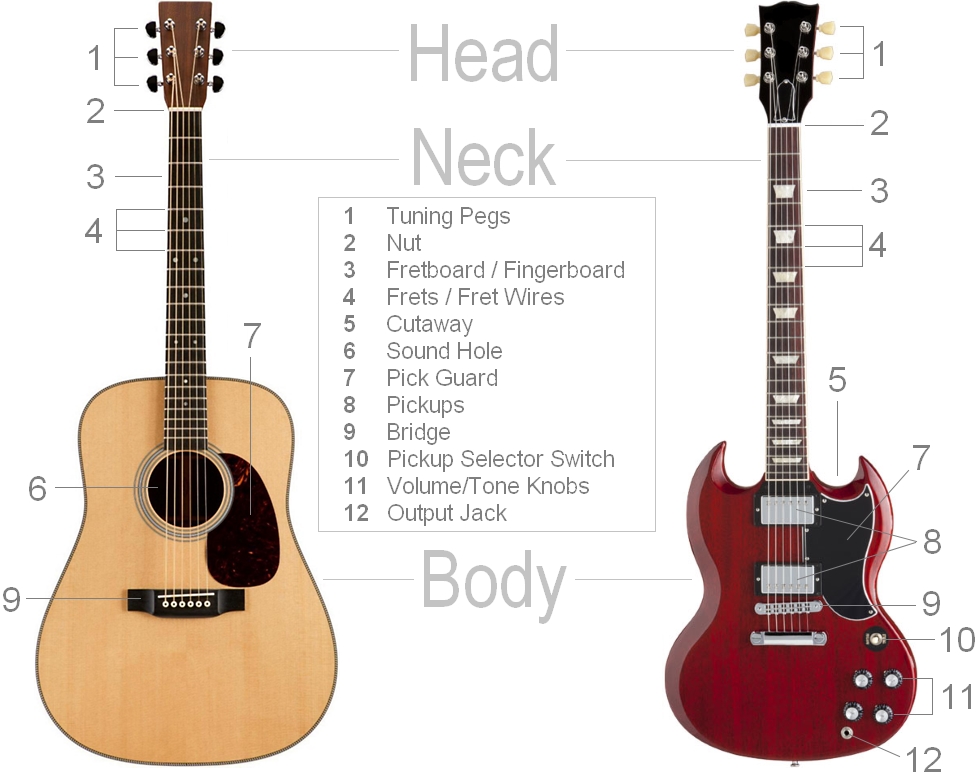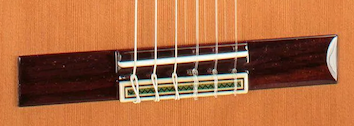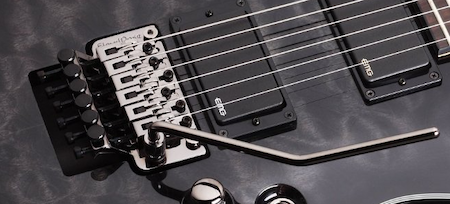The Anatomy of the Guitar

- Soundboard
- Top
- Back & Sides
- Sound Hole
- Cutaways
- Bridge & Pins
- Bridge
- Saddle
- Bracing
- Electronics
- Pickups
- Controls & Selector
- Acoustic
The soundboard, or 'top' of an acoustic guitar is a key component of the guitar. As the guitar strings are strum, the soundboard vibrates to help amplify the sound of instrument. Different types of wood, 'tonewood', give acoustic guitars their own particular sound. Popular choices of wood include spruce, cedar, mahogany and maple. The construction of the soundboard can be laminate (multiple plies glued together), or solid (a single layer of wood). From top to bottom, the body is divided into the upper bout, the waist, and the lower bout.
- Electric
Electric guitars have been made from a number of astonishing materials. Some guitar makers have used steel, plastics, hemp and other rarities. Most are made of wood - the most common woods for an electric guitar are ash, alder, mahogany, rosewood, maple and ebony. From top to bottom, the body is divided into the upper bout, the waist, and the lower bout. Electric guitar bodies can be solid, hollow, or a blend of the two, and some might come in strange shapes.
- Acoustic
The back and sides of an acoustic guitar are just as important, and like the soundboard, are available in laminate or solid construction. The wood choice for the back and sides is often of a type more rigid than the top - rigid back and sides help project the sound back towards the soundboard rather than absorbing it, adding to the resonance and sustain. Rosewood and mahogany are popular wood choices for this.
- Acoustic
The sound hole, or 'mouth' of the acoustic guitar is not the only, or main place that the sound comes from. The sound emanates from the vibrating top, the vibrating strings, and other surfaces. A larger sized body (combination of top, back and sides) on an acoustic guitar will produce a louder sound. The sound hole helps to focus outward the projection of this sound.
The main purpose of a cutaway is to make sure your hand can more easily access the upper frets on the fingerboard. Cutaways also reduce bodyweight, and affect to shape of a guitar. The 'horns' of a guitar are a result of the cutaways. Cutaways are more common on electric guitars. Cutaways can affect tone particularly on acoustic guitars because they reduce the size of the body.
- Acoustic
The acoustic guitar's strings are held in place at the bridge by the bridge pins. These are commonly made of plastic, although bone and synthetic bone material ones are also available. The bridge pins are inserted into the bridge. The bridge secures the strings to the body of the guitar, provides a stable base for the strings to vibrate, and transmits their vibration to the soundboard.
Bridges may consist of a single material, usually wood for acoustic guitars, or they may be made of several parts and include other materials such as plastic or bone. On classical and steel string guitars, the bridge is glued to the top.
Classical guitars do not normally use bridge pins, though some exceptions exist, and instead use a tie block, which originated in Spain.

- Electric
The bridge or 'tailpiece', secures the strings to the body of the guitar and provides a stable base for the strings to vibrate. There are many kinds of bridges, from simple steel bars to complex vibrato systems with whammy bars which can be waggled to change the pitch of the notes.

- Acoustic
The saddle on the acoustic guitar is responsible for the string height at the bridge. It's a key component in the transfer of vibration from the strings to the top of the guitar. The saddle is available in a variety of tone-enhancing materials, each material affects the tone of the sound.
- Acoustic
The strings on the guitar put a large amount of tension on the neck and top of the guitar. The strings are kept perpetually stretched in order to provide the desired musical note vibration for each string, this effectively pulls the top end of the guitar towards the bottom, in an attempt of the strings to return back to a normal state. So acoustic guitars are braced inside to help strengthen the top and sides. The most common method is called 'X bracing', as this type of bracing forms an 'X' shape along the underside of the soundboard.
- Acoustic
Many acoustic guitars also feature a pickup and preamp section so that they can be plugged into an electric amplifier. The most common type of pickup is a piezo transducer, which coverts vibrations into electrical signals. There's also systems that include microphones, magnetic pickups, or a blend of these. The converted signal runs through a preamp which might offer EQ, volume controls, and often features such as a sound tuner.
- Electric
The pickups are the soul of an electric guitar. Fitting in different pickups can drastically alter a guitar's tone. A pickup's function is to capture the vibration of the strings via a magnetic field, and send this signal to your amplifier. There are four main types. Single coils are brighter sounding but produce hum; humbuckers were invented to cancel this hum and have a warmer tone; P-90s are a type of single coil which provide a more rounded sound, and active pickups have battery-powered circuitry to provide a boosted sound for rock and metal styles.
- Electric
Most electric guitars have tone and volume controls. On a guitar with more than one pickup, the pickup selector switch can be used to choose either a combination of pickups, or to have the sound come form just one. This allows one guitar to make different tones. Pickups nearer the neck are bassier and used for rhythm sounds. Pickups nearer the bridge have more treble and favored for lead guitar sounds.
Guitar neck materials vary, but most are made from maple or mahogany. The way they join the body affects sustain and tone. Most are bolted on, glued in, or extended through the guitar's body. Neck 'profile' refers to the thickness and shape of the neck. Different neck profiles exist to suit small or large hands.
Laminated to the front of the neck is the fingerboard or 'fretboard'. It is generally made from a different type of wood as the back of the neck and is fretted. Common fingerboard woods are ebony, rosewood and maple. Each has a tonal character. Light colored maple is described as 'bright', and browner rosewood as 'warm'. Ebony, generally black, combines characteristics of both. Most fingerboards have inlays to improve looks and provide a visual reference. Guitar fingerboards vary in radius, referring to how rounded or flat they are. This has a subtle effect on the way the guitar feels.
Guitar frets are raised parts on the fingerboard that extend across the full width of the neck, and are generally made of metal. Frets divide the guitar neck into intervals, each fret representing one semitone of an octave. Pressing the string against the fret shortens the string to the length between the fretted point and the bridge, changing the note and making it easier to achieve correct notes than a non-fretted fingerboard. Frets come in different shapes and types, subtlely affecting the way the guitar feels.
The top nut affects string spacing and the height of the strings above the fretboard - this is referred to as the 'action' of a guitar. If it's too high you'll have to work hard to press and hold the strings on the frets when playing, resulting in much less speed and ease.
At the top of the neck is the headstock or 'peghead'. Headstocks can be straight or angled, and come in many different shapes depending on maker and model. The main purpose of a headstock is to hold the machineheads, or the mechanisms that hold the strings at the "head" of the instrument. Apart from its main function, the headstock is an important decorative detail of a guitar. It is the place where the majority of guitar manufacturers draw their logo, some have signature headstock designs that make their guitars or guitar series easily recognizable.
The machineheads are geared pegs that hold the strings in place and are used to tune the strings to pitch. Once a string is held in place at the bridge and is attached to the machinehead, the machine head can be turned to adjust the tension on the string. Nicknamed tuners, they come in various shapes and sizes, and sophisticated designs, but all do the same job allow the guitar to be tuned.
- Acoustic
Classical guitar strings are primarily used for classical and flamenco pieces and are made of materials such as nylon, fluorocarbon, and other synthetics. Their bass strings may have a threaded or solid core which is covered with windings of various metals and nylon. The sound of classical guitar strings varies extensively, depending upon the materials used and the manufacturing techniques involved. In general nylon based strings offer a warmer sonic color and more sustain.
- Acoustic
The sound of acoustic guitar strings varies extensively, depending on which materials and manufacturing techniques are used. The sound you want will vary somewhat based on whether you play folk, bluegrass, country, acoustic rock, or another musical genre.
Wound strings made from softer metals like gold with a core made with significant amounts of a soft, pliant material like silk will produce a warm, mellow tone with less volume.
Strings made with harder metals like stainless steel — especially if they have a solid metal core, will produce a bright sound with more volume.
- Electric
Electric Guitar Strings are used most frequently for the rock, jazz, and country styles. Like acoustic guitar strings they are made of metals, but primarily steel or nickel. They have a core of metal which is covered in a metal winding. While the relative hardness or softness of the metals involved is a factor, their character is primarily driven by the magnetic properties of the metals involved, unlike acoustic strings, since their sound is defined by their interaction with the magnetic pickups of an electric guitar.